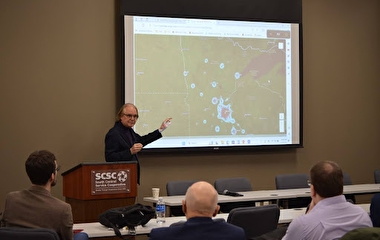A crew of maintenance workers using stencils, rollers, and paint to apply pavement markings is a common sight—but a new robot has the potential to revolutionize this process. Researchers at the University of Minnesota Duluth (UMD) have created a fully functioning robotic roadway painter that they say will “completely change” the way messages and symbols are painted on the roadway.
The project’s goal was to create a large-scale, vehicle-mounted robotic roadway message painter that could be run by a single operator and to develop software that enables the robot to automatically paint messages and symbols on roadways. The project, sponsored by the Minnesota Department of Transportation, was led by Ryan Rosandich, an associate professor of mechanical and industrial engineering at UMD; it builds on his research team’s earlier development of a successful trailer-based prototype that was used to demonstrate the feasibility of robotically painting messages and symbols on a roadway.
“Pavement marking messages are expensive and labor intensive to maintain,” says Victor Lund, traffic engineer for St. Louis County. “The concept of a robotic painter has the potential to reduce these costs and the impact to traffic.”
Researchers moved through several design challenges over the course of the project. “Our initial design included a frame-mounted robot attached to the front of a truck, but when this design presented drawbacks, we changed the concept to a completely new, articulated robot arm that folds flat against the front of the truck,” Rosandich says. “In addition, we developed a control system, operator interface, paint-delivery system, truck mount, and mobile power supply.”
The finished system was thoroughly tested, and programs were written to allow the robot to paint several symbols and messages on the roadway. These programs were then tested and fine-tuned indoors and finally outdoors once the robot was mounted on the truck. This portion of the project produced several interesting findings.
“We found that the traditional pavement markings used by MnDOT are not ideal for robot application,” Rosandich says. “Robotic painting can be better accommodated by altering the outlines of the markings somewhat, and by using hash lines to fill in the symbols rather than solid paint. Helpfully, these machine-made markings are actually faster to apply and use less paint, and in the end may be more effective for motorists than the traditional markings.”
The new robot has the potential to provide several important benefits. Fewer workers will be exposed to the work zone, for a shorter period of time, because the system can be controlled by a single operator from the safety of the vehicle’s cab. Productivity will improve because painting operations can be conducted more quickly with less labor. And greater flexibility is possible because the system is not limited to stencils and is able to paint virtually any character or symbol on the roadway.
The technology has been licensed to Epic Solutions of Fargo, ND, for commercialization. “We expect to see the benefits of this technology grow in the future as these techniques are expanded to other areas such as automated crack-filling and automated pothole repair,” Rosandich says.



